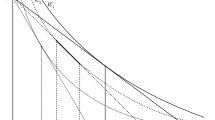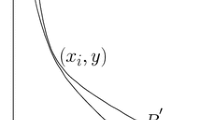Abstract
This paper incorporates objectives of both legislators and bureaucrats in a model of public sector decisionmaking. Existing models assume that either bureaucrats control production information and decisions, (Niskanen-type models) or legislators control production decisions (legislative models). My model explicitly incorporates imperfect agent behavior and corresponding preferences of both legislators and bureaucrats to reflect the bilateral nature of appropriations. The analysis shows that output levels generally differ from politically and socially efficient levels and depend on the relative weights of legislative and bureaucratic interests. Accordingly, Niskanen-type and legislative models are viewed as special cases of this more general approach.
Similar content being viewed by others
References
Ahlbrandt, R. (1973). Efficiency in the provision of fire services.Public Choice 16: 1–15.
Amacher, R.C., Tollison, R.D. and Willett, T.D. (1976). Risk avoidance and political advertising: Neglected issues in the literature on budget size in a democracy. In R.C. Amacher, R.D. Tollison and T.D. Willett (Eds.),The economic approach to public policy, 405–433. Ithaca: Cornell University Press.
Bennett, J.T. and Orzechowski, W.P. (1983). The voting behavior of bureaucrats: Some empirical evidence.Public Choice 41: 271–283.
Borcherding, T.E. (1977).Budgets and bureaucrats. Durham, NC: Duke University Press.
Borcherding, T.E. (1988). Some revisionist thoughts on the theory of public bureaucracy.European Journal of Political Economy 4: 47–64.
Breton, A. and Wintrobe, R. (1975). The equilibrium size of a budget maximizing bureau: A note on Niskanen's theory of bureaucracy.Journal of Political Economy 83: 194–207.
Bush, W. and Denzau, A.T. (1977). The voting behavior of bureaucrats and public sector growth. In T.E. Borcherding (Ed.),Budgets and bureaucrats: 90–99. Durham, NC: Duke University Press.
Carroll, K.A. (1990). Bureau competition and inefficiency: A reevaluation of theory and evidence.Journal of Economic Behavior and Organization 13: 21–40.
Chan, K.S. and Mestelman, S. (1988). Institutions, efficiency and the strategic behaviour of sponsors and bureaus.Journal of Public Economics 37: 91–102.
Cohon, J. and Marks, D. (1973). Multiobjective screening models and water resources investment.Water Resources Research 11: 826
Davies, D.G. (1971). The efficiency of public versus private firms: The case of Australia's two airlines.Journal of Law and Economics 14: 149–165.
Eavey, C.L. and Miller, G.J. (1984). Bureaucratic agenda control: Imposition or bargaining?American Political Science Review 78: 719–733.
Fenno, R.J. (1966).The power of the purse. Boston: Little, Brown.
Fiorina, M.P. and Noll, R.G. (1978). Voters, bureaucrats and legislators.Journal of Public Economics 9: 239–254.
Haefele, E. (1970). Coalitions, minority representation, and vote-trading probabilities.Public Choice 8: 75.
Holcombe, R.G. and Price, E.O. (1978). Optimality and the institutional structure of bureaucracy.Public Choice 33: 55–60.
Johnson, R.N. and Libecap, G.D. (1980). Agency costs and the assignment of property rights: The case of southwestern Indian reservations.Southern Economic Journal 47: 332–347.
Keeney, R. (1973). A decision analysis with multiple objectives: The Mexico City airport.Bell Journal of Economics and Management Science 4: 101.
Libecap, G.D. (1978). Economic variables and the development of the law: The case of western mineral rights.Journal of Economic History 38: 338–362.
Libecap, G.D. (1981). Bureaucratic opposition to the assignment of property rights: Overgrazing on the western range.Journal of Economic History 41: 151–158.
Lindsay, C.M. (1976). A theory of government enterprise.Journal of Political Economy 84: 1061–1077.
Mackay, R.J. and Weaver, C.L. (1979). On the mutuality of interests between bureaus and high demand review committees: A perverse result.Public Choice 34: 481–491.
Mackay, R.J. and Weaver, C.L. (1981). Agenda control by budget maximizers in a multi-bureau setting.Public Choice 37: 447–472.
Marglin, S. (1967).Public investment criteria. Cambridge, MA: MIT Press.
Margolis, J. (1975). Comment.Journal of Law and Economics 18: 645–659.
Migue, J.-L. and Belanger, G. (1974). Toward a general theory of managerial discretion.Public Choice 17: 26–43.
Miller, G.J. (1977). Bureaucratic compliance as a game on the unit square.Public Choice 29: 37–51.
Moene, K.O. (1986). Types of bureaucratic interaction.Journal of Public Economics 29: 333–345.
Niskanen, W.A. (1971).Bureaucracy and representative government. Chicago: Aldine-Atherton.
Niskanen, W.A. (1975). Bureaucrats and politicians.Journal of Law and Economics 18: 617–643.
Orzechowski, W.P. (1977). Economic models of bureaucracy: Survey, extension, and evidence. In T.E. Borcherding (Ed.),Budgets and bureaucrats, 229–259. Durham, NC: Duke University Press.
Romer, T. and Rosenthal, H. (1978). Political resource allocation, controlled agendas, and the status quo.Public Choice 33: 27–43.
Spann, R.M. (1977a). Public versus private provision of government services. In T.E. Borcherding (Ed.),Budgets and bureaucrats, 71–89. Durham, NC: Duke University Press.
Spann, R.M. (1977b). Rates of productivity change and the growth of state and local governmental expenditures. In T.E. Borcherding (Ed.),Budgets and bureaucrats, 100–129. Durham, NC: Duke University Press.
Thompson, E.A. (1973). Book review of Niskanen (1971).Journal of Economic Literature 11 (September): 950–953.
Tullock, G. (1974). Dynamic hypothesis on bureaucracy.Public Choice 19: 127–131.
Weingast, B.R. (1984). The congressional-bureaucratic system: a principal-agent perspective (with application to the SEC).Public Choice 44: 147–191.
Weingast, B.R. and Marschall, W. (1988). The industrial organization of congress, or why legislatures, like firms, are not organized as markets.Journal of Political Economy 96: 132–163.
Weingast, B.R. and Moran, M.J. (1983). Bureaucratic discretion or congressional control? Regulatory policymaking by the Federal Trade Commission.Journal of Political Economy 91: 765–800.
Weingast, B.R., Shepsle, K.A. and Johnsen, C. (1981). The political economy of benefits and costs: A neoclassical approach to distributive politics.Journal of Political Economy 89: 642–664.
Wildavsky, A. (1964).The politics of the budgetary process. Boston: Little, Brown.
Wildavsky, A. (1988).The new politics of the budgetary process. Glenview, IL: Scott, Foresman.
Author information
Authors and Affiliations
Additional information
The author wishes to thank Douglas J. Lamdin, Thomas E. Borcherding, Kim Knapp, and two anonymous referees for helpful comments on earlier drafts of this paper.
Rights and permissions
About this article
Cite this article
Carroll, K.A. The effects of multiple objectives in the theory of public sector supply. Public Choice 75, 1–20 (1993). https://doi.org/10.1007/BF01053878
Accepted:
Issue Date:
DOI: https://doi.org/10.1007/BF01053878




